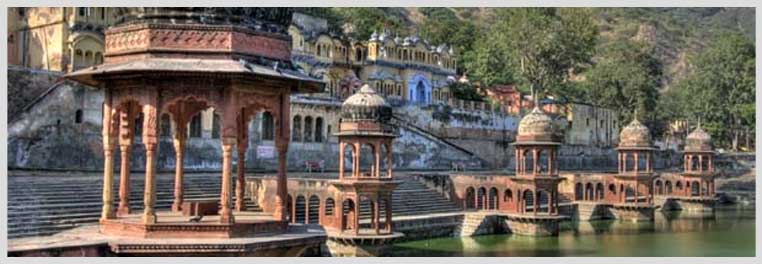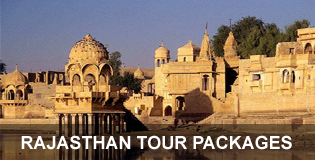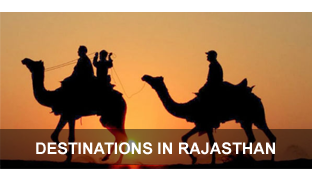Alwar - The City of the Rajputs

Alwar, amongst the Rajput principalities was closest to imperial- Delhi, hence the turbulence of its people and history. Formerly known as Mewat, the men of Alwar developed a hardy, reckless attitude to life. They did not submit to alien rule, they rebelled. They were daring adventurers. Marauders in the 12th and 13th centuries they would band together and raid Delhi at night. The western gates of the Muslim capital had to be barred every evening against their coming. Sultan Balban (12671287) finally crushed their disorganised resistance as a result they came under Muslim rule. In 1771, Maharaja Pratap Singh, a Kachchwaha Rajput belonging to the same clan as the one that ruled Jaipur, won back Alwar from the Mughals and founded a principality of his own.
Alwar lies equidistant from Delhi and Jaipur. The Aravallis break up a beautiful little valley with small hills and rocky crags before trailing off in the final spine that runs right up to and through Delhi, known as The Ridge. The city nestles between several small hills, on the most prominent of which stands a dramatically forbidding fort. Lakes and valleys thickly wooded in parts, have made this area the haunt of -animals and birds. Rich in wildlife, Alwar has one of the finest sanctuaries in Rajasthan.
What to see
Many events of history have occurred in this fort, which is as old as the Rajputana State. Babar, the Mughal emperor, spent a few days here and when he left, he took with him the hidden treasures for his son, Humayaun. Akbar's son, Salim, later Emperor Jehàngir was exiled for three years. The palace where he stayed is called Salim Mahal and is in ruins now. It was finally conquered by Maharaja Pratap Singh in 1775 A.D. The fort is 595 metres above sea level and 304 metres above the city, and extends about 5 km from north to south and 1 .6 km from east to west. It has 15 large and 51 small towers which contain 446 loopholes for musketry. And eight towers all around defend it. The fort is, however, not opened to tourists now. There are several gates, namely, Jai Pol, Suraj Pol, Laxman Pol, Chand Pol, Krishan Pol and Andheri Gate. Though most of the structures within, project a faded glory, their historical significance is still important. There are the remains of Jai Mahal, Nikumbh Mahal, Salim Sagar Pond, Suraj Kund an many other temples. The view of the city below, from the watch towers of the battlements, 'is breath-taking.
Today it is more popularly known as the Vinay Vilas Mahal. The architecture here is not so old. It belongs to the late 18th century and traces of Rajput and Mughal styles of architecture are evident. The ground floor has been converted into-Government offices and district courts. It houses a museum in one upper apartment-of the palace. -
The museum probably has the richest collection of Mughal and Rajput paintings of the 18th and 19th centuries. There are some really precious ancient manuscripts in Persian,. Arabic, Urdu and Sanskrit. Some major ones are—'Gulistan' (the garden of roses), 'Waqiate Babri' (autobiography of the Mughal Emperor Babar) and 'Bostan' (poems). One exhibit that instantly attracts attention is a huge silver table used for entertaining British nobility in the days of the Raj. It also has a copy of the 'Mahabharata' painted by the artists of the Aiwar school. Another special collection here is the collection of Indian armoury—diverse and amazing. - Behind the City Palace, are located other monuments worth a visit. There are a few temples on the bank of sagar'—tne amliclal tang OUI1I Dy ivianaraja vinay Singh. There is a cenotaph of Maharaja Bakhtawar Singh. It was built by Maharaja Vina(y Singh in 1815 A.D. It is a beautiful chhatri, unique in its style of the unusual Bengali roof and arches. It is also known locally as the Moosi Maharani Ki Chhatri.
Originally known as Company Bagh, later it was' changed to Purjan Vihar by Maharaja Jai Singh, the great lover of Hindi language. The garden was laid out during the reign of Maharaja Shiv Dan Singh in 1868 A.D. It has an enchanting setting. The people of Alwar call the fernery, 'Shimla', which was built by Maharaja Mangal Singh in 1,885 A.D. The cool shades and lush greenery here, never let the heat of summer seep in.
Excursions
10 km. The royal residence, built by Maharaja Jai Singh in 1918, overlooks a scenic, rippling beautiful lake. A splendid temple of Sita Ram, is visited by multitude of devotees especially on the occasion of Ram Navami. Prior permission from the Secretary of former Maharaja is required to visit the palace.
13 km. It offers a bewitching scenery. The twinkling ripples, covering 10.5 sq km is surrounded by thick wooded hills with beautiful chhatris on the embankment. It was once a source of Alwars water supply. Cradled in the hills and overlooking the lake it used to be a magnificent Royal Hunting Lodge. It was built by Maharaja Vinay Singh for his village queen Shila in 1845. Today it is a comfortable Hotel and a delightful spot for film-makers.
6 km. It is accessible by road from Alwar. It 'is a large artificial lake constructed by Maharaja Jai Singh in 1910. It makes an excellent picnic spot during the rainy season with beautiful lush greenery all around.
37 km. On Alwar—Jaipur state highway. Nestling in picturesque valley of the Aravallis ,a forest comes to life. It pulses a beat of its own. The native rhythm reveals wildlife in its own natural habitat. This sanctuary, established in 1955, offers an exceptionally unique opportunity to see a variety of animals at a close range. There are tiger, nilgai (blue bull), sambhar, cheetal (spotted deer), four-horned antelope and wild bear. The thick forests here are the dry deciduous type and cover an area of 480 sq. km. There is a spectacular palace here built by Maharaja Jai Singh in honour of the Duke of Endinbürgh when he visited the sanctuary. RTDC Hotel Tiger Den and Sariska Palace (a heritage hotel) offer comfortable accommodation.
The best time for a drive in the sanctuary is between 0630 hrs and 1600' hrs.
| Foreigner | Indian | |
|---|---|---|
| Per head | Rs 25 | Rs 5 |
| Still Camera | Rs 10 | Rs 2 |
| 8 mm movie Camera | Rs 50 | Rs 50 |
| 16mm movie Camera | Rs 100 | Rs 100 |
Bus Rs 100; Mini Bus Rs 50; Diesel Jeep Rs 100; Petrol Jeep or Car Rs 75 Jeeps are available on hire at the RT.DC Tiger Den Hotel Charges : Rs 400 per jeep (up to 5 persons) - extra person. - Rs 50 per head. Night halt in the sanctuary is allowed only after obtaining OTHER USEFUL INFORMATION prior permission from the Field Director, Sariska Tiger Reserve (In special cases only).
Area : 44.76 sq. km.
Climate : Mean Max Mean Mm
Summer : 37.0°C 24.0°C
Winter : 31.0°C 11.0°C
Rainfall : 62 cm.
Best Season : September-February
Languages : English, Hindi, Rajasthani
Local Transport :Un metered auto-rickshaws. Also cycle-rickshaws and tongas
Travel Information
Air: Delhi 163 km is the convenient airport.
Rail :Good connection from prominent locations in and around the State.
Road : Regular services link Alwar with key destinations in and not far off from Rajasthan.
Jewellery and other handicraft items. A sweetmeat speciality made of milk-kalakand is not to be missed. Market areas are Hope Circus, Bazaza Bazar, Sarafa Bazar, Malakhera Bazar, Kedalganj Bazar.
State Bank of India, Mahal Chowk Tel 21448, Bank of Baroda, Hope Circus. Tel 20138, State Bank of Bikaner and Jaipur, Opp. Police Control Room, Tel 20813
GPO Tel 22631, Telegraph Office Tel 21249
Jaikrishna Club, Lions Club, Rotary Club, Inner Wheel Club, Jaycees Club and Leo Club.
General Hospital, Zenana Hospital, Ayurvedic Hospital and private hospitals.
Nature Cure Hospital; Yoga Kendra, Nehru Bal Vihar.
VK Studio, Malakhera Bazar; Shyam Studio, Church Road; Friends Studio, Near Ghanta Ghar;Mehta Studios, Church Road.
Tourist Information Bureau, Opp Company Garden, Nehru Bal Vihar Tel 21868
For approved guides contact Tourist Office Tel: 21868






